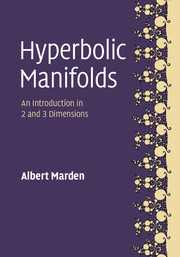Book contents
- Frontmatter
- Dedication
- Contents
- List of Illustrations
- Preface
- 1 Hyperbolic space and its isometries
- 2 Discrete groups
- 3 Properties of hyperbolic manifolds
- 4 Algebraic and geometric convergence
- 5 Deformation spaces and the ends of manifolds
- 6 Hyperbolization
- 7 Line geometry
- 8 Right hexagons and hyperbolic trigonometry
- Bibliography
- Index
Preface
Published online by Cambridge University Press: 05 January 2016
- Frontmatter
- Dedication
- Contents
- List of Illustrations
- Preface
- 1 Hyperbolic space and its isometries
- 2 Discrete groups
- 3 Properties of hyperbolic manifolds
- 4 Algebraic and geometric convergence
- 5 Deformation spaces and the ends of manifolds
- 6 Hyperbolization
- 7 Line geometry
- 8 Right hexagons and hyperbolic trigonometry
- Bibliography
- Index
Summary
To a topologist a teacup is the same as a bagel, but they are not the same to a geometer. By analogy, it is one thing to know the topology of a 3-manifold, another thing entirely to know its geometry—to find its shortest curves and their lengths, to make constructions with polyhedra, etc. In a word, we want to do geometry in the manifold just like we do geometry in euclidean space.
But do general 3-manifolds have “natural” metrics? For a start we might wonder when they carry one of the standards: the euclidean, spherical or hyperbolic metric. The latter is least known and not often taught; in the stream of mathematics it has always been something of an outlier. However it turns out that it is a big mistake to just ignore it! We now know that the interiors of “most” compact 3-manifolds carry a hyperbolic metric.
It is the purpose of this book to explain the geometry of hyperbolic manifolds. We will examine both the existence theory and the structure theory.
Why embark on such a study? Well after all, we do live in three dimensions; our brains are specifically wired to see well in space. It seems perfectly reasonable if not compelling to respond to the challenge of understanding the range of possibilities. For a while, it had even been considered that our own visual universe may be hyperbolic, although it is now believed that it is euclidean.
The twentieth-century history. Although Poincaré recognized in 1881 that Möbius transformations extend from the complex plane to upper half-space, the development of the theory of three-dimensional hyperbolic manifolds had to wait for progress in three-dimensional topology. It was as late as the mid-1950s that Papakyriakopoulos confirmed the validity of Dehn's Lemma and the Loop Theorem. Once that occurred, the wraps were off.
In the early 1960s, while 3-manifold topology was booming ahead, the theory of kleinian groups was abruptly awoken from its long somnolence by a brilliant discovery of Lars Ahlfors. Kleinian groups are the discrete isometry groups of hyperbolic 3-space. Working (as always) in the context of complex analysis, Ahlfors discovered their finiteness property.
- Type
- Chapter
- Information
- Hyperbolic ManifoldsAn Introduction in 2 and 3 Dimensions, pp. xiii - xviiiPublisher: Cambridge University PressPrint publication year: 2016

